It’s a generally accepted fact in America that when you say “Middle East” you are inferring “desert” in the same breath. Throughout our lives we are generally conditioned that everything “over there” is sandy, dry, and generally a lot like the American southwest, except a lot bigger and filled with people in turbans. But after spending the better half of my long Easter weekend in the northern reaches of Jordan, I have to wonder: is North Jordan even in the same country?
I mentioned this last month when Christine and I had our brief trip into Jerash, but all of Jordan north of Amman is completely different looking. In the south, you’re lucky if you can find a few short, scrubby trees by the side of the road to have a picnic under like so many Ammanites do, but in the north, hills covered in trees and wildflowers of many varieties are nothing to write home about. However, I knew that once the summer sun hit the wildflowers of the north, there wouldn’t be much left save to sweep into a dustbin. I asked Dozan wa Awtar a few weeks ago if anyone wanted to join Silas and myself in a trip to the north in a post-concert celebration, and Ala’ and another American named Janell decided that they would go with us. That is to say, the trip wouldn’t have gone very far without Ala’, as he was driving!
Leaving at 5:45 probably wasn’t required, but as Friday was Good Friday for Orthodox Christians like Ala’, we knew we needed to be back in Amman by 6 so that he could get to church. So I purposely planned the trip for as early as I thought we could safely hit the road without all of us dying in a sleep-induced flaming car crash. Janell and Silas brought snacks, bless them, and I kept everyone awake and focused with loud and increasingly redundant exclamation of “Wow! It sure does look different up here!” I like to think I was performing an important role.
We reached the still-empty parking lot of Um Qais at 8. From this corner, the ruined city looked like nothing more than a windswept, grassy hillock with a few curious-looking boulders on the top, but after paying our 3 JD admission to the smiling guard (the kitaab kezzab (lying book) said it would be 1 JD) we found that the whole area swept down the hill into a large, crumbling city with a definite separation of histories – from the early Roman periods to the later Byzantine. Um Qais was originally a Roman city named Gadara, and was populated as part of the Roman Decapolis from 218 BC to 747 AD, when it was destroyed by earthquakes and abandoned.
The first thing that we noticed were, of course, the flowers. Basem had mentioned to me that there was a kind of flower, whose English name he couldn’t recall, that spread like feathery red wildfire over the hills, and now that I saw it myself, I recognized them as poppies. That, combined with the yellow flower that I had already seen last month in Jerash, made the hills practically glow with color. The four of us had just finished checking out a ruined archway near the entrance, when suddenly we heard the sound of 20 voices roar out “ALLAHU AKBAR!” – the phrase that probably every American knows as “God is the Greatest,” although it’s become unfortunately infamous for other reasons. As Silas and I ducked for cover (just kidding) Janell peaked around the corner and saw a troop of what looked like Jordanian Boy Scouts march down the steps into the park. They were followed by a tall, stocky guy in camo who casually swung a meter-long machine gun, complete with a sniper scope, over his shoulder. I don’t think I’ve ever been that close to live, loaded military hardware like that before.
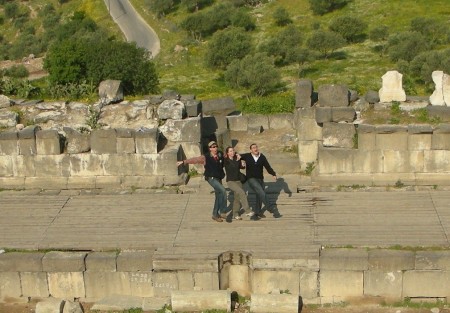
I'm half-happy, half sad that there wasn't a full audience in the theatre to bask in our amazing performance...
Next on our path was the South Theatre complex, the better preserved of the two in the city. Almost everything, with the exception of wooden planks that cover the stage, is original and authentic, carved from solid blocks of huge black basalt stone. Because of its position and west-facing front, it was comparably shielded from the elements compared with the North Theatre, which suffered greatly over the centuries. We climbed all over the cracked seats, and put on a small production for ourselves – a kickline, something we never would have attempted had there actually been other tourists around. We climbed the 30 meters up to the highest seats and looked over the back, realizing that the boy scout troop was actually there to pick up litter; I gave them serious respect when I saw them running about with bags, excitedly piling cans and wrappers like treasures and racing to beat their fellows to a new piece of garbage. As they saw us poke our heads above the rubble on the top, they waved to us happily and shouted “hello! hello, how are you!”
The most impressive feature of Um Qais is the large open courtyard, which archeologists tell us served similar religious purposes during both the early Roman and Byzantine periods, with a temple on the north side, and a Byzantine church on the south side. Here’s a picture of it below, clicking it will take you to the Flickr photo album for the entire North Jordan series. We had fun posing on the columns, and Silas showed off his fluent knowledge of German by reading all the signposts, which were put up in English, Arabic, and German. I had Ala’ read the Arabic side too, which I understood much more than the German, which although is my family bloodline still just sounds like coughing and clearing throats.
As we sat next to the “Nymphaeum,” we got our first incredible look across the 6 kilometer expanse of valley and the village of Hamat Ghader to the mountains of Syria, specifically, the infamous Golan Heights, one of the targets of the 1967 Israeli “expansion.” The air was so clear that the mountains of Golan and the Sea of Galilee to the east were like looking through a telescope. For such a contentious region, peering down at the white strip of road that separates Jordan and the region revealed no troops or bases, just picturesque farmland and greenhouses. This may seem like an odd statement, but if anyone has ever played Final Fantasy X for the PS2, think about what it was like the first time you entered the Calm Lands region and looked across to the other side. This view was like that, except in real life and many times more spectacular. I’d post a picture for comparison if I could find any online from the game.
After our rest, we continued westward along a well-worn stone road, chariot wheel marks etched deeply into the stone. Bees buzzed around us in an audible drone, and the old stone columns cast staid shadows onto our heads as we passed under them. Interestingly enough, it wasn’t long before we came across an area not mentioned in my guide book, in which Egyptian workers labored by hand and with backhoes to clear dirt and stones from columns and ruins which emerged from the ground. Or were they truly being “discovered” – or placed? I joked with Ala’ that the Jordanian government had discovered how profitable tourism could be and were scrambling to start building more ruins as quickly as possible to capitalize on this. My joke gained even more leverage when we came across a neat cluster of column pieces that were placed on the ground in a group, colored differently than anything else; I felt like I had accidentally come a little too close to the mark. We only stayed in this area for a few minutes before turning back to return to the marked areas; without any signs or mention of what this area was in my book, it seemed pointless to tarry further.
Before moving onto the museum, we decided to investigate a small blue shack that was placed on one of the north-eastern hills. We picked our way across half-buried rubble that signs told us had once been a cathedral, only to find that it wasn’t a shack, it was actually a military guard post. Finally, some sort of sign that there is some sort of watching of Israel going on! The guards were reading a newspaper, machine guns lying on the rocks next to them. One of them was drinking coffee out of a thermos and gazing thoughtfully at the Sea of Galilee when we arrived. They greeted us warmly, and their eyes widened when they saw Ala’. They asked him, in Arabic, “Are you the guide for these Americans?” which he denied, saying he was just a friend traveling with us. I was about to take a picture of the Sea from this new vantage point, but as I brought my hand to the camera pouch at my waist, the soldiers suddenly both jumped up, shaking their heads. I thought at first that it was in response to the fact that I had a black holster on my hip (I get that a lot at the constant security checkpoints here) but it just turned out that they were forbidding me from photographing an area so close to their watchtower, for security purposes. Of course, I agreed, and we bid them a pleasant farewell.
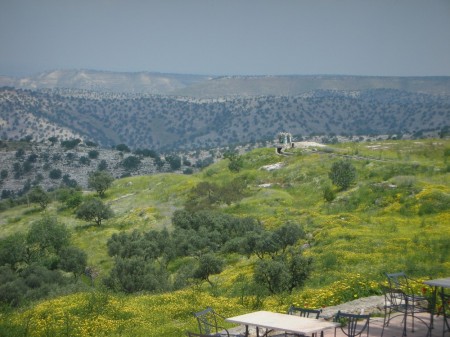
Just because I couldn't take a picture right next to them doesn't mean I couldn't take one later! (and I did)
As we turned away from the guard post, we suddenly realized that we were facing the almost-invisible remains of the North Theatre, which has lost almost all resemblance to a man-made construction and is merely a grassy bowl scooped out of a hill, the stone seats long since pulled out for use elsewhere or buried under meters of dirt and grass. A single solitary olive tree stood in the middle of it, seeming to be mocking man’s futile attempts to bring nature under his control. No matter what, no matter how long you think you will last, the tree told us smugly as we climbed the yellow-flowered slope towards the museum, eventually all your buildings and great structures will be nothing but grassy ruins like the one currently nourishing my roots.
It would appear that a nameless philosopher had the same idea, pondering his own mortality near the time of his death. In a dusty corner of the museum courtyard, a simple basalt block bears a Greek inscription, which when translated reads as: “Oh you passerby, heed my words: As you are now, I used to be. As I am now, so you shall be. Treat life as a mortal should.” According to my book and the guide who appeared out of an office to to translate the Greek into Arabic for Ala’ (who translated it to us), the block was taken from where archeologists believed there had once been an extensive cemetery. I wonder what the philosopher would have thought if he could see his old city now, a couple millenia later?
We had a long, leisurely lunch in an open-air restaurant named The Resthouse, which both my book and friends back in Amman had told me had simply amazing views over Golan. Neither the views nor the food disappointed; highly recommended for anyone hot and tired after several hours of sightseeing. As we ate our pasta, hoummus, and kubbe (small breaded balls of meat and onion), we watched the park gradually go from 20 visitors to several hundred, and the noise level increased accordingly. I mused that my book had really come in handy at long last; it had warned to go early in the spring when the flowers were out, because of how popular the park is with both Arabs and tourists, and the former pays no admission charge at all. In particular, Palestinians love to visit the site because of the sweeping views the east end of the mountain affords of their old homeland and family farms, wrested from their ownership perhaps decades earlier. Back in the previously-deserted parking lot, we suddenly found ourselves picking through vendors hawking candy, toys, and flower leis to everyone they could reach, especially westerners. We “leh, shukran”‘d (no thank you) our way to the car, and turned our faces south to head towards the famous castle of Ajloun.
Ajloun is one of those castles that looks straight out of an old English movie. Huge and stately, of course, but situated perfectly atop a tree-covered mountain that can be seen from 20 kilometers in every direction. Like Um Qais, there was a large number of tourists here too, but almost no westerners – entirely Arab young people enjoying their weekends and playing in the rocks. Young men, about high school age by my estimation, ran about snapping pictures of each other posing and leaning against the ancient bricks like models in shades. Silas and Janell, who had been here before, immediately headed up towards the roof to take in the full effect of the view, leaving Ala’ and myself to meander at our leisure through the dark, drafty stone halls, lit only with eerie lights built into the floor stones. I bet the original army of Saladin would have appreciated little conveniences like that during their stay in the late 12th century, protecting the territory against the invading Crusader armies from the south and west.
I felt like I was back in England again, exploring the ruins of Conwy Castle in Wales – and I’m sure that this won’t be the last time I link to that entry; I loved my tour of that place! Just like Conwy, there were no guards shouting at me to get away from the edges, and I greatly enjoyed being able to explore at my leisure – although I wish there were more signs and plaques telling me what I was looking at, or at least even a pamphlet to try to decipher. Ala’ and I took it upon ourselves to explore every nook and cranny we could find, especially ones that were unlit. In one particular instant, he and I crossed through a darkened chamber, going towards what I thought (well, hoped) was a human skull on the floor – alas, poor Yorick! – but turned out to only be a large rock with two eye-socket-shaped dents on it. A small girl, leaning over a railing above us, screamed suddenly “Mommy Mommy Mommy!” when she saw two dark shapes shuffling towards her out of the darkness, and I heard her feet pound away across the room above us. I reached up towards the railing, wondering what the problem was, then saw the sign: Dangerous Area. Apparently, the child had figured that anything coming out of a dark, dangerous area could only be that: dangerous.
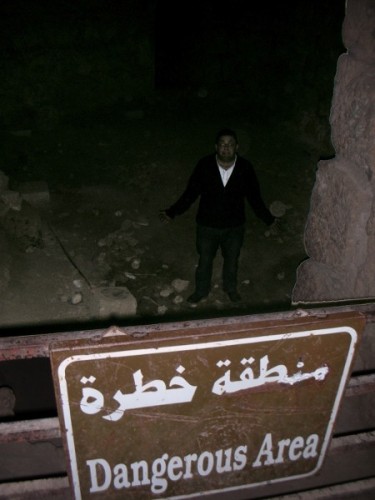
Poor Ala', pigeon-holed as being dangerous. I don't think he has a threatening bone in his body!
But we decided to live up to our new reputation of being bad to the bone. We climbed up things that we had no business climbing up, and finding little crawl spaces to squeeze through. Ironically, after we had climbed up to the top of another section of the tower and forced our way through some more blocked-off areas, I came across the same little girl and her mother and frightened her a second time. “Sorry!” I called out through the hole in the wall after her retreating back as she ran away, crying. I probably accidentally turned this little kid off of castles for her entire life.
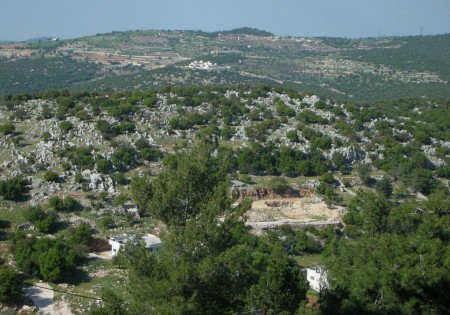
A photo taken from the highest battlement of the castle. Looks like a great place to play Ghost in the Graveyard late at night, until you got a concussion.
I would have loved to have stayed for a little longer, but Ala’ needed to get back to Amman and we were all pretty tired from our 12 hours of exploring – plus, Janell’s snacks weren’t going to last forever in a hot car. The one dinar admission fee us Americans paid to get in was the best single note I’ve ever spent though – I definitely feel like I got my money’s worth there and would love to go back again. I kept my eyes glued to the imposing silhouette of the castle for as long as I could see it, framed by the setting afternoon sun, which was a good 10 minutes after we’d left! And one thing’s for sure: I’ll never make the mistake of thinking that everything in this part of the world is just one big shifting pile of desert sand – I found myself wishing dearly that the original King Abdullah the first had just decided to shift his new capitol up a good 50 kilometers to this beautiful landscape when he christened Amman as his ruling city 60 years ago. Returning to Amman (and to “Jordan” after being in this foreign country of green vitality) was sweet sorrow for me after being surrounded by so much beautifully nature, but little did I know that I’d be going north yet again to Jerash tomorrow after the Easter church service on the top of Mount Nebo…
Time permitting, insha’allah I will be able to write the blog entry on that trip tomorrow afternoon after work. And of course, I encourage to click here to check out the Flickr photos!
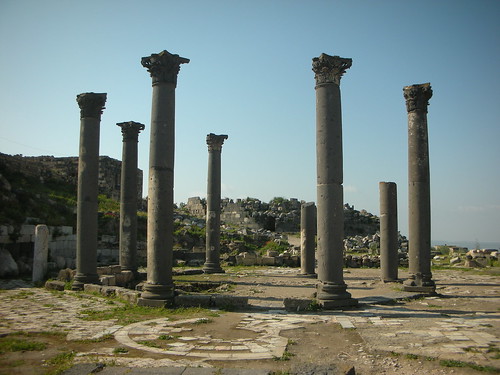


Machine gun…with a sniper scope? Are you sure it wasn’t just an automatic rifle?
You expect me to have become an expert on different kinds of assault weaponry just because I’ve lived in the Arab world for 9 months? Cut me some slack here!